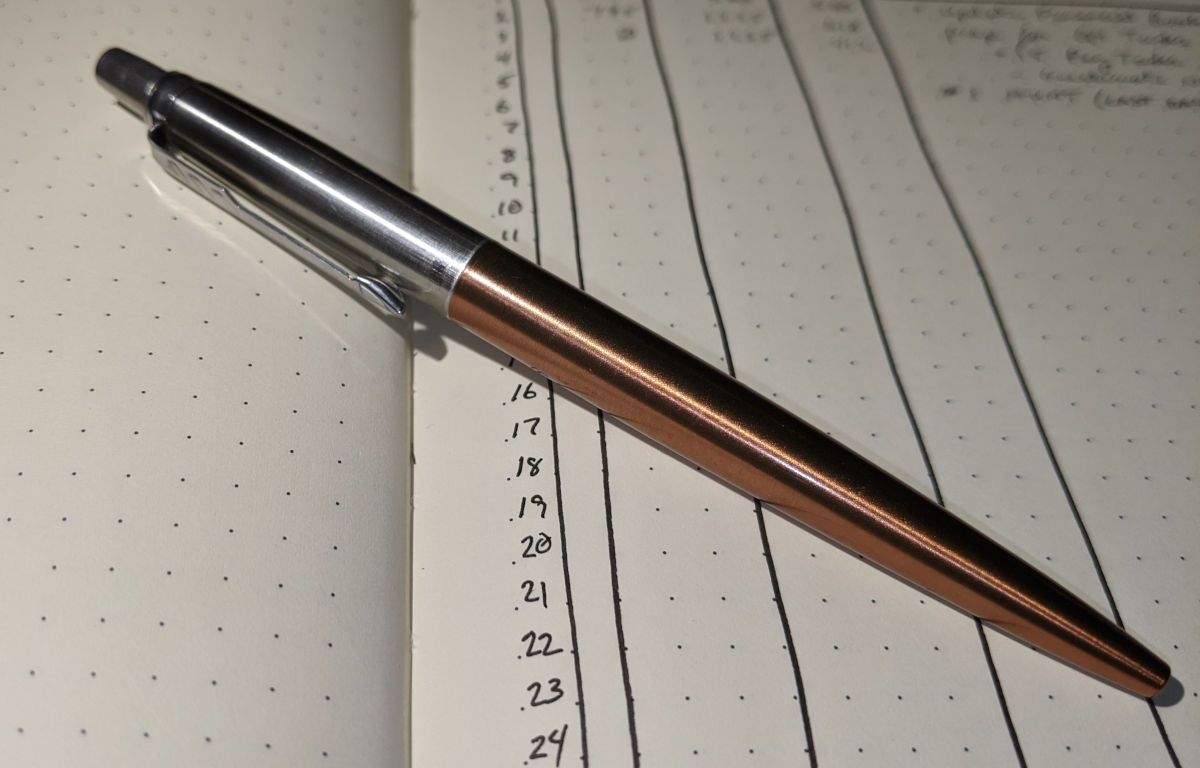Note, this has been cross-posted between blogs: Tandem Realty's In Tandem and Errant Ruminant's Ruminations.
So, you've heard about this whole bullet journal thing but don't know a ton about it. In this article, I will walk you through the basics and demonstrate how I set myself up for the new year (2020).
Bullet journaling has taken the productivity world by storm. At its most basic, it's a methodology for ordering your life that can be as simple as you want it to be or as complex. It shuns the rigidity and complexity of past systems (ahem, FranklinCovey), and adapts to you as much as you to it. After years of one system after another—and often no system—I adopted bullet journaling in May of 2019 and I never looked back. As I have boldly stated (with only a smidgeon of added hyperbole) on more than a few social media posts: bullet journaling has changed my life.
The Bullet Journal Method was conceived in 2013 by designer Ryder Carroll after years of struggling to align his need for a more organized life with the challenges associated to attention deficit hyperactivity disorder (ADHD).
This post intends only to show my initial setup for the year 2020. If you need a better broad-brush overview of what bullet journaling actually is and the basic methodology, perhaps you would be better served by watching these two videos first (the second one particularly rocks):
- Bullet Journal: Start Here by user Bullet Journal (4 minutes). The Learn page on the Bullet Journal website is also a great summary (and links to the same video). Additionally, consider buying his book. It's: (a) a good read, and (b) a great think piece on productivity and introspection. Here's a bit about what the book dives into. Thank you, Ryder!
- THE BULLET JOURNAL METHOD by Ryder Carroll | Core Message by user Productivity Game (10 minutes). This video is awesome!
Warning: A search for bullet journaling on the internet will quickly lead you down a road teeming with scrapbookers, artists, and obsessive compulsives—folks that value aesthetics over function, or merely 'obsess'. These folks have somewhat skewed the core message of what bullet journaling is all about. Don't be intimidated! The core message of bullet journaling is productivity. A journal can be beautiful or it can be purely functional. It can even be both. But in the end, getting stuff done is the primary point of the bullet journalling method. The whole point of bullet journaling is to be easy, efficient, and useful. Bullet journaling as a productive tool should be nearly effortless. That being said, make it your own. BuJo customization is boundless.
The secret to bullet journaling may be its simplicity, but also its ability to help a practitioner be more intentional and mindful. It combines the concept of a planner, notebook, and a journal all in one old-school analogue: a paper journal. It doesn't necessarily replace things like detailed calendaring and project-planning tools, but instead augments them.
Basic Tools
The base requirements to get started are trivial: a notebook and a pen. But since this is something you will be using all the time and carrying around with you everywhere, I recommend a higher-quality notebook and pen. Now that BuJo (bullet journaling) has taken off, notebooks specifically designed to serve the BuJo-community have also flooded the market. Here are my current favorite notebook and pen as well an alternative for each:
Notebook
-
Favorite: Exceed A5 Dotted Journal — "Bullet Journal" and "100 GSM" is on the label. Originally a Walmart-only brand. $9 at Walmart.
-
Alternative: Leuchtturm 1917 A5 Dotted Notebook — 80 GSM. This is often the #1 pick by reviewers. $20 from Amazon. You can even buy a branded version of this from bulletjournal.com.
Ironically neither one of these comes with a pen-loop. I wish they did. Last year, I made my own and it worked out really well. This year, I will probably do the same. You can also buy one separately if you like.
Pen
- Favorite: Parker Jotter Gel — $20 available at just about any office or stationary supply store.
- Alternative: Pilot G2 Gel — $12 (and cheaper) available at just about any office or stationary supply store.
Useful Extras
- Correction Tape
- 0.5 Mechanical Pencil and Retractable Eraser
- Faber-Castell Pitt Artist Pens — India Ink (4 sizes, black). $8 available at just about any office or stationary supply store.
Ultimately, a composition notebook and any ol' pencil or pen will do, but high-quality supplies tend to make the experience more enjoyable, which increases the likelihood that the habit will stick. The notebook can be lined, graph-ruled, or dotted; but dotted notebooks have become quite popular because they are a great compromise between the need to compose text and the need to draw things . . . all without being overly intrusive.
The Core Principles
The core concept behind the Bullet Journal Method is "rapid logging": itemized to-dos (tasks), events, and notes that are set apart from free-form notes and journaling. Most everything is collected in temporal views of months, weeks (for some), and days; with other things broken out into more topical views called Collections. Log items are not necessarily fixed in place: as tasks don't get done, a decision is made to either cancel them or migrate them to another planning moment. This continuous exercise in introspection and decision-making is, in my humble opinion, the most powerful and important element of the bullet journal methodology.
The symbology of rapid logging
| Bullets | Task resolution | My qualifiers | . . . | . . . |
|---|---|---|---|---|
| ⚫ Task | ⤫ complete | * highlight | F farm | N novel |
| ⚬ Events | > migrated forward in time | ** highlight! | W writing | B blog |
| —− Notes | < migrated back in time | R real estate | P poetry | |
| T tech | O other writing |
The notebook is broken into units of organization
- Index — as notes and journal entries are expanded over time, an index is also developed. This index exists to reduce the need for ad hoc searches throughout the notebook. A concise and useful index also frees up the structure of the notebook: a unit of logging or journaling can be stuck anywhere in the notebook and an updated index used to find it again.
- Future Log — a month-by-month summary of tasks and events.
- Monthly Logs + Daily Logs — each month begins with a summary of the month ahead (usually two or more pages) and is then followed by individual daily logs. As each month arrives, tasks are migrated from the Future Log to this month's log and then fleshed out as tasks, goals, and events. As each day is encountered, tasks are migrated from the month view and further fleshed out for that particular day. Each month and day is tackled as they come. (Note, some folks also use a Weekly Log. I don't but probably would if I still worked in a corporate environment.)
- Collections — for informational pieces, projects, or complex tasks, a collection may be appropriate. A collection aggregates large swathes of ideas and notes that have a similar topic or theme into a multi-page spread. For example, I have 1001 things to accomplish for the farm this coming year, therefore I created a collection called "Farm Tasks" and then another called "Farm Thoughts and Ideas".
A core principle here is that pre-planned items only exist in the Future Log, and maybe in a Collection. The rest of the journal is fleshed out as you get to each moment in time. A Monthly Log is only fleshed out when you get to that month. Each Daily Log is only fleshed out the night before that day begins (and further fleshed out during the next day). That is: Every night, I prep the next day's Daily Log. At the end of every month, I prep the next month's Monthly Log. At the end of every year, I prep a whole new Bullet Journal to include the twelve months of a Future Log. Tasks and events are migrated forward in time and expanded as required. Future planning lands in the Future Log.
Note: If you have COPIOUS future-planning to perform (consumed by meetings and projects like I used to be?), then the Future Log probably needs to be expanded and Weekly Logs (in addition to the Monthly Logs) may make sense. That being said, personally, I'd have to explore how much of my meeting schedule I would want to track in a Bullet Journal. If you need to track a billion meetings like I used to do, a digital calendar is required anyway. That being said, I do tend to write out my next day's meeting schedule every night in the Daily Log. The Daily Log is for tracking detail and not really the Future, Monthly, or Weekly Log.
My Journal Layout for 2020
Last year, I winged it (but still followed the core principles) and my journaling experience turned out be pretty spectacular. This year, armed with the knowledge of 2019, I did a bit of pre-planning. During the planning process, I initially penciled everything in. When satisfied I inked everything over. It took a little time, but my 2020 journal will start off just a little bit cleaner than my 2019 one.
For the purpose of using my journal as a demonstration device, I included example data (tasks, events, etc.) in pencil in the photos. There is not a ton of detail, but it should be enough for clue folks into what is going on. Though you are free to use a pencil (for example, I will be using a pencil for the Bill Collections pages until the format settles down), I recommend using ink as you update your bullet journal throughout the year. It forces more thoughtful introspection and won't tend to fade over time. Made a mistake? Scribble through the error and move on. A bullet journal doesn't need to be perfectly neat and tidy. In fact, learning to accept this imperfection would likely be beneficial as well.
The Notebook and Pen
As I mentioned previously, I really like the Exceed A5 Bullet Journal. It can be found at most Walmarts. The pen is a Parker Jotter Gel, but anything will do.
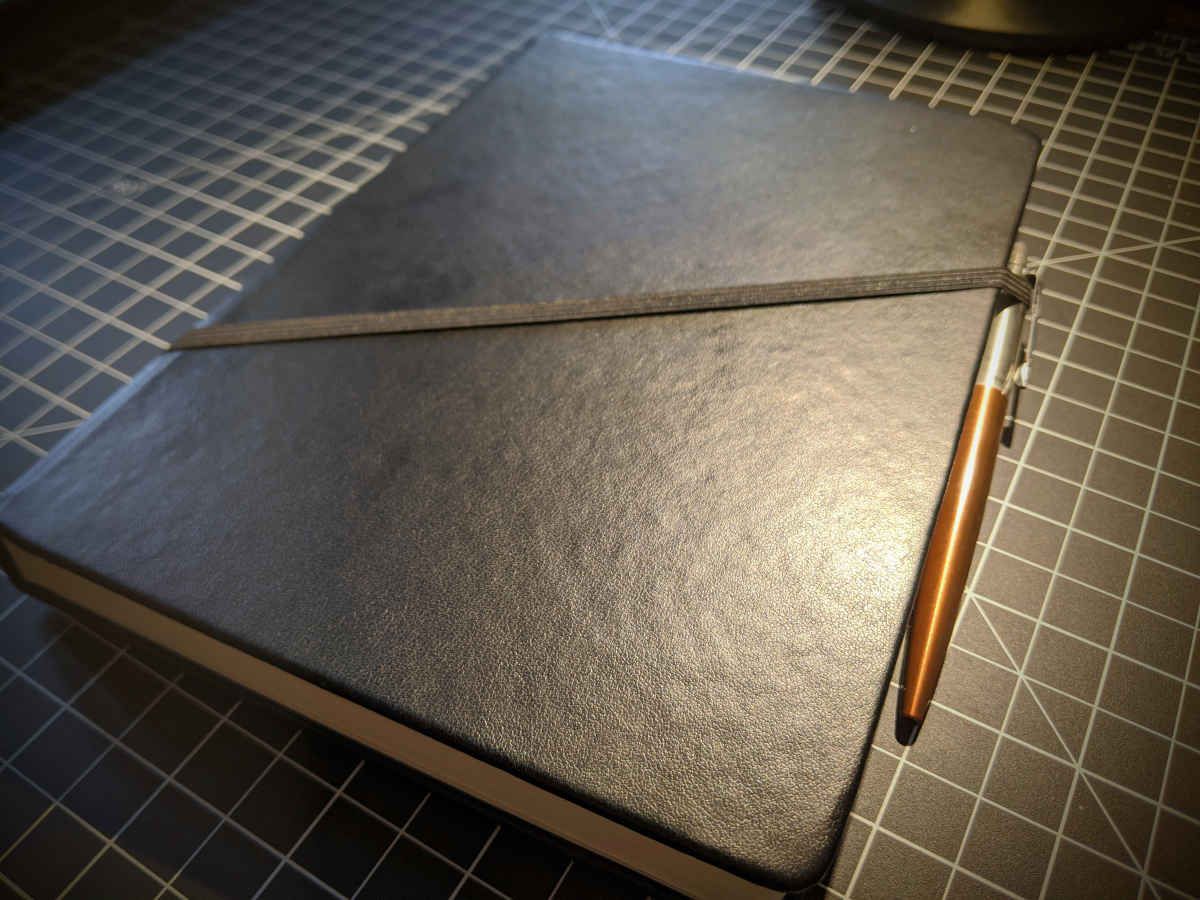
The First Few Pages
Stick your name and phone number in the front. There are a lot of Good Samaritans out there, but keep in mind that sensitive data should not be written in your journal—passwords, treasure maps, etc. Side note: Exceed's branding on that first page leaves much to be desired.
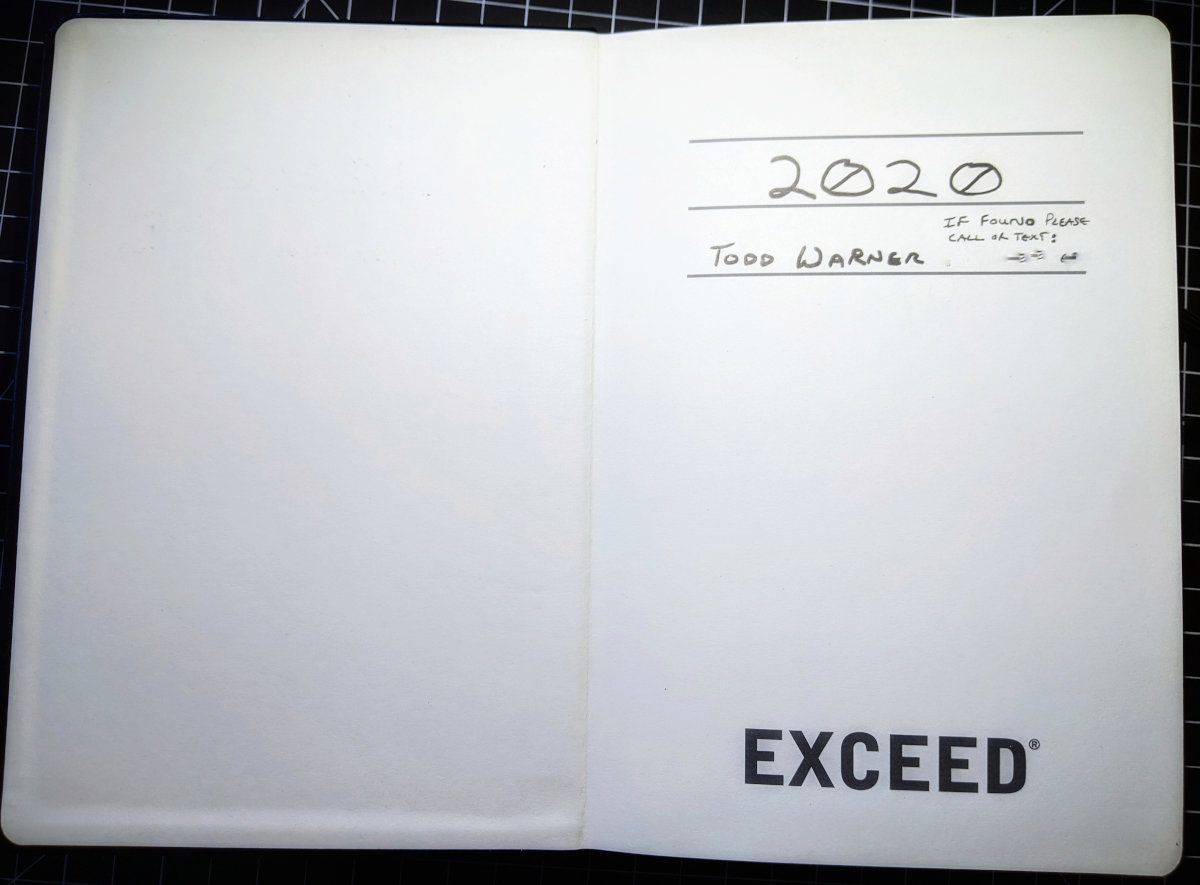
Next we come to the "Index" (many notebooks come with pages already dedicated to it). I have some pre-planned pages within the journal and have already added them to the index. As the journal grows, so will the index. For example, if the two pages I allocated to the "Writing Ideas" collection is not enough, I will pick two more pages somewhere in the journal and update the index entry so that it might look something like "Writing Ideas 18-19, 63-64".
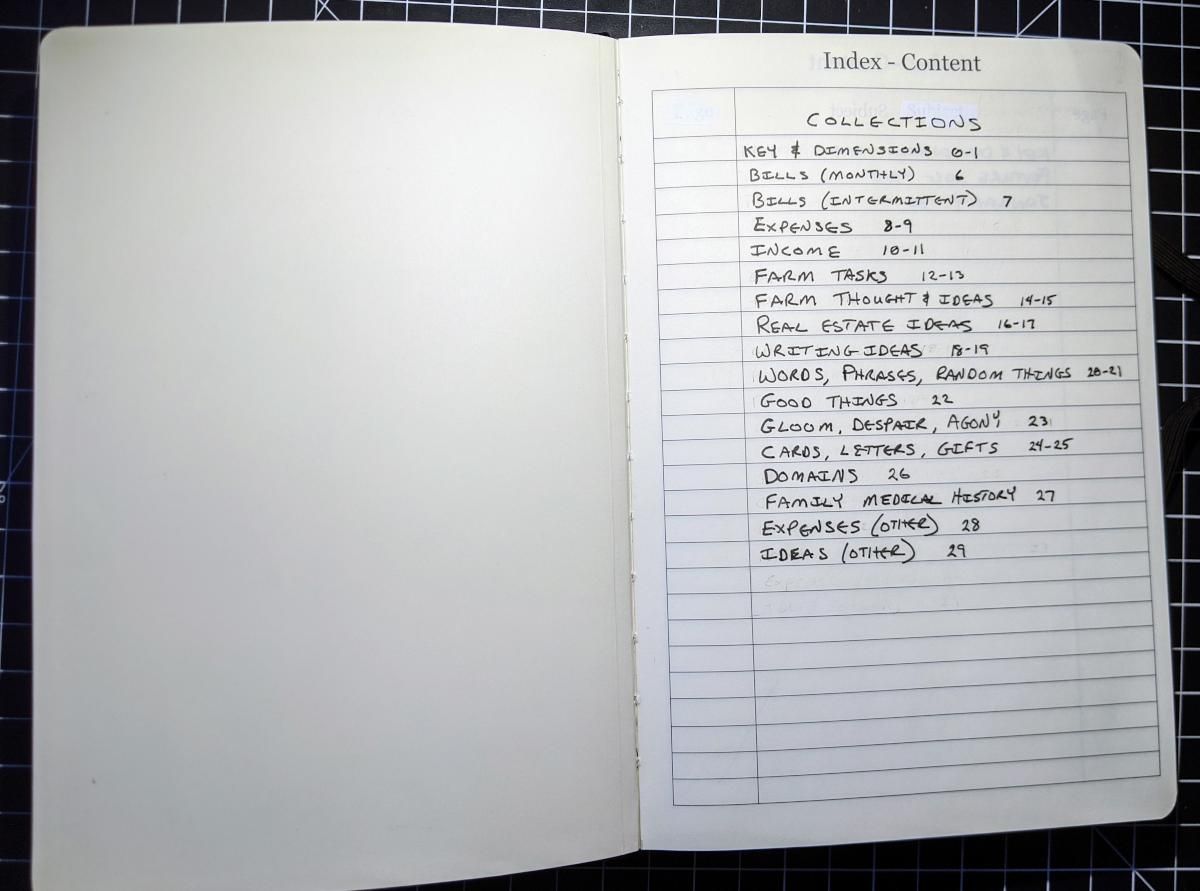
For 2020, I estimate I will probably not add more collections than fit on that first page, so I decided to simply make that first page of the index all collections. Of course, if I go beyond that one index page, so be it.
The second page (and onward) will have everything else. I.e., anything I want to keep a reference to that is not a collection will go here. (Not pictured are two more blank index pages provided by the notebook manufacturer.)
You may notice some splotches of white-out. The notebook manufacturer has Pages and Subject at the top of those columns. I prefer the pages off to the right of the entry, so I blanked-out the header labels. I will use that narrow left column for qualifiers like F (farm), W (writing), etc.
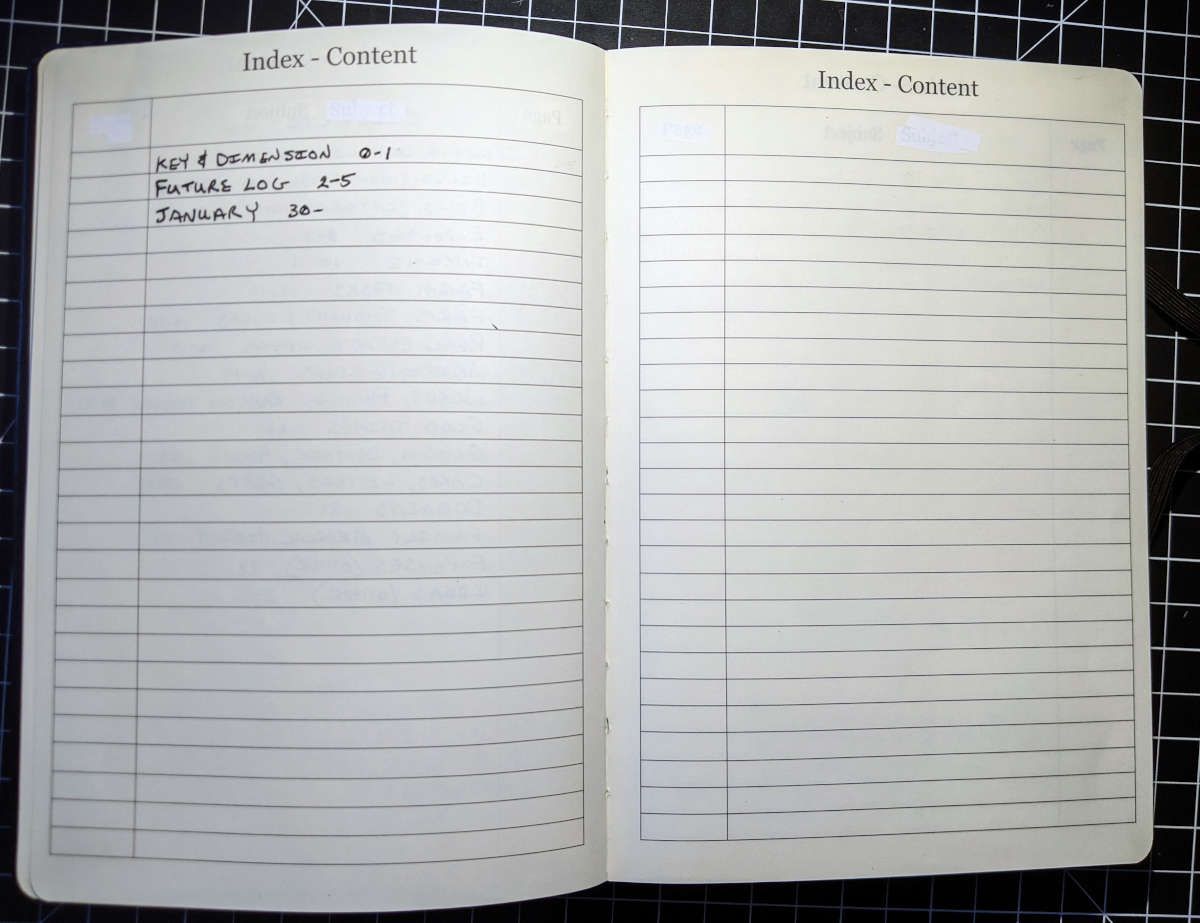
Key and Dimensions
This is my journal and not to be used by anyone else. But for the sake of uniformity (and convenience) I like to write down my own key and plot out basic page dimensions. These are for my own reference and will help maintain some consistency. Many people don't bother with these pages, but even a short chart of symbols can be convenient.
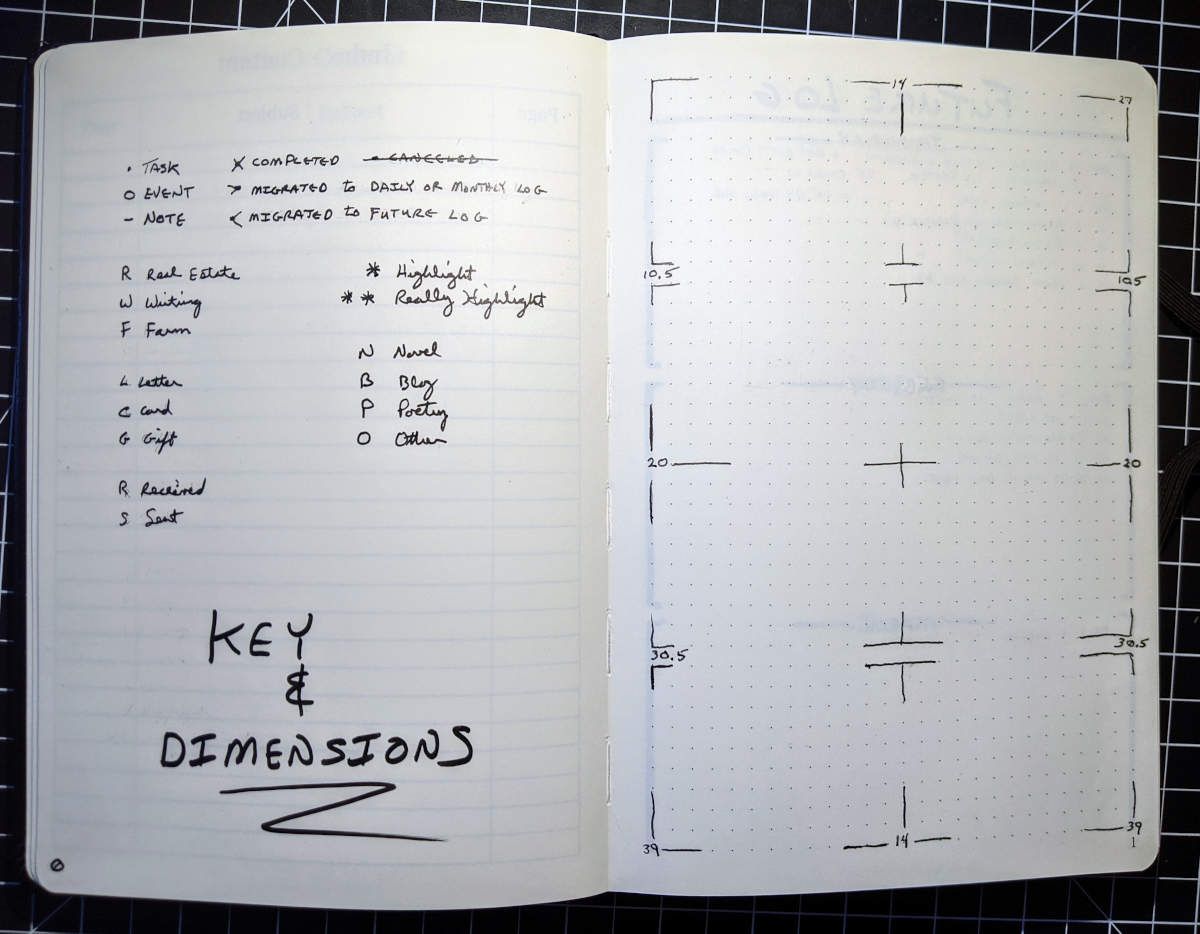
Future Log
Getting the Future Log to match anyone's particular needs takes some experimentation. I like dividing the pages into thirds for each month. The Future Log is for big to-dos and events whereas more detail gets broken down in the monthly and daily logs (and the weekly log that some people use). I suspect that if I still worked a corporate job, I would use 1/2 a page for each month or maybe even have months spanned across two pages but cut into thirds (three months per two pages). I would probably explore using weekly logs as well. The great thing about a bullet journal is that if it gets all screwed up, I can just redo it somewhere else in the notebook. Heck, I have even cut out pages before. I have glued two-page spreads together because they were disasters of design and planning. The index is there so nothing gets lost. And, of course, attaching a permanent bookmark (a bit of tape) is super handy. I digress.
The point of the Future Log is to track big events and to-dos. As a new month is approached, tasks are migrated and events are mirrored from the Future Log (and from prior months if left incomplete) to the monthly + daily logs.
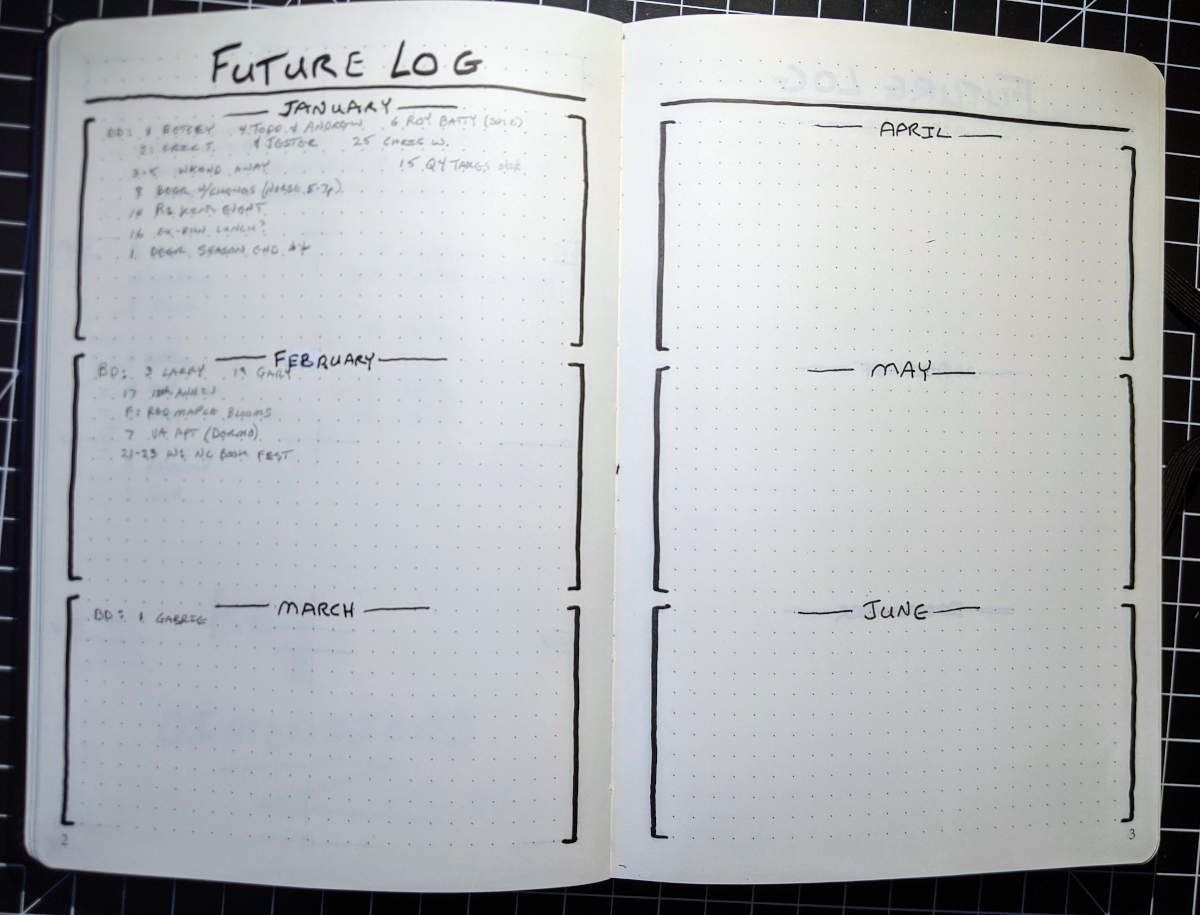
One may notice that nearly every item in my Future Log is an event. There is no need to denote them as such with the ⚬ symbol. Anything that doesn't begin with a dot or a dash is an event. Generally, my format is "day of month" then "event summary". One may also see an "R" for real estate, "W" for writing, "F" for farm, etc. The only tasks that I personally put in the Future Log are really large ones (projects and such). That being said, I change my mind about Future Log formatting all the time.
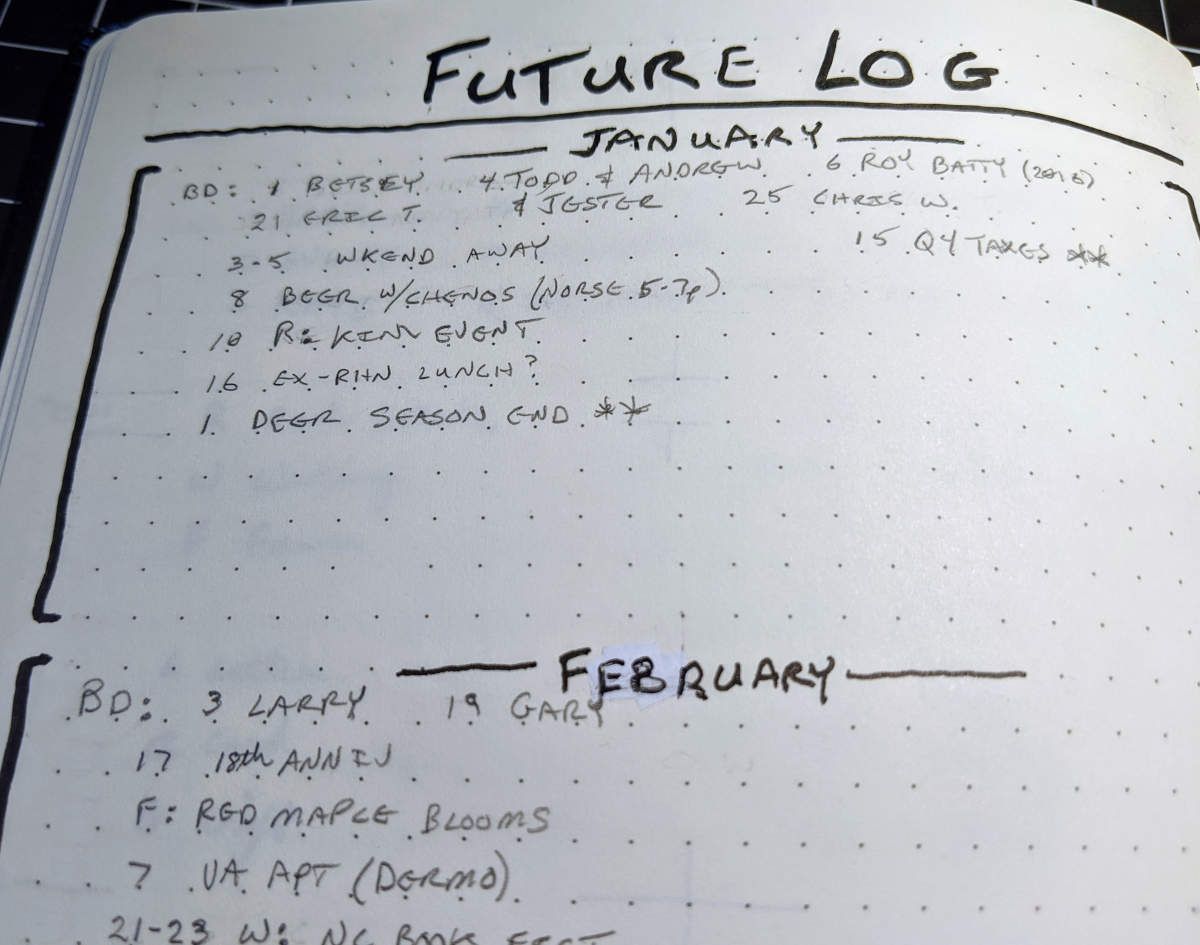
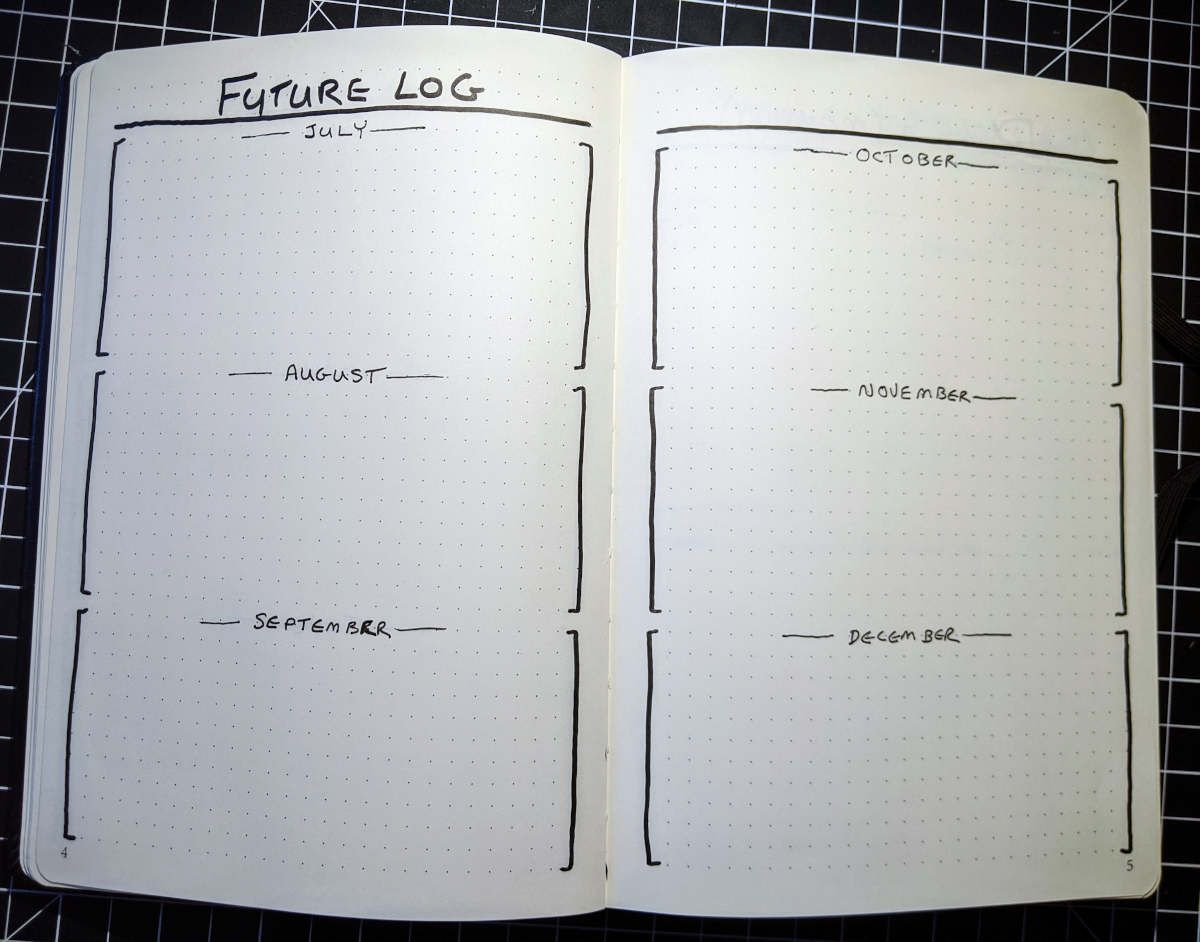
Collections
Some collections are more task-driven. Others primarily contain bulleted notes or even free-form text. Some are tables of data. Most are a mix of things. Collections are where whole piles of data about a particular subject are aggregated that you may then act upon, scattering tasks throughout a timeline.
For example, I keep a budget elsewhere, but in my journal I like to keep two listings of bills just for reference. One collection is for monthly bills, the other for non-monthly bills (like that magazine subscription I renew every two years or my annual life-insurance premium payment). I could just re-list all bills every single month in each "Month Log", but I would find that silly, personally. Keep them all in a collection for reference, and if you need to take action on any of them, only then add that task to the running monthly task list, which will then migrate to a daily log at some point as a reminder for it to be completed. I will do that for all taxation tasks, for example.
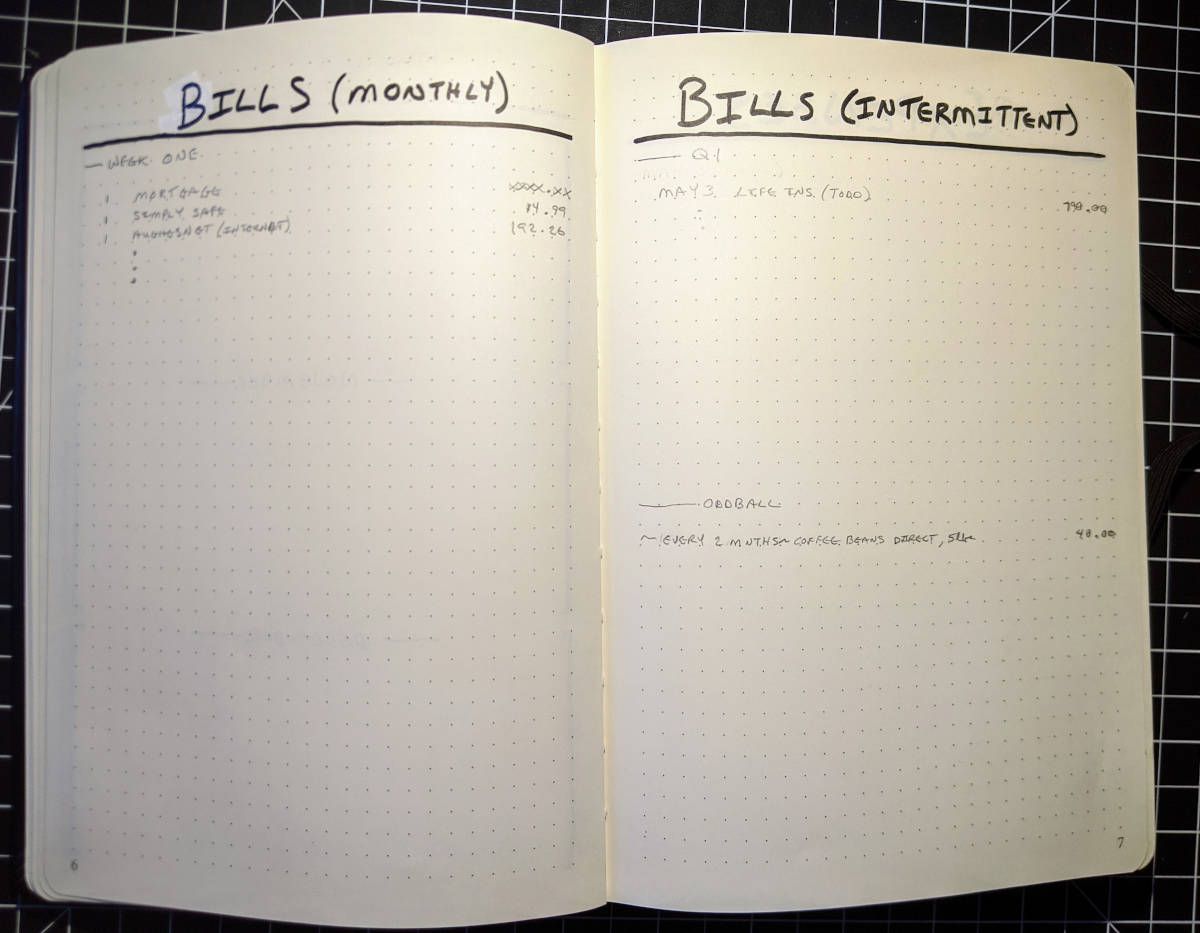
Similarly, I plan to track expenses (two pages) and income (two pages—not shown) within the journal. Not all expenses and income will be tracked, but enough to keep a ballpark idea of where we are in any given month (we also keep proper books). This will serve as a summary for all of our businesses in one location. We'll see how valuable this is (I'm skeptical that it will be). If it isn't, I will scribble out those pages and ditch them.
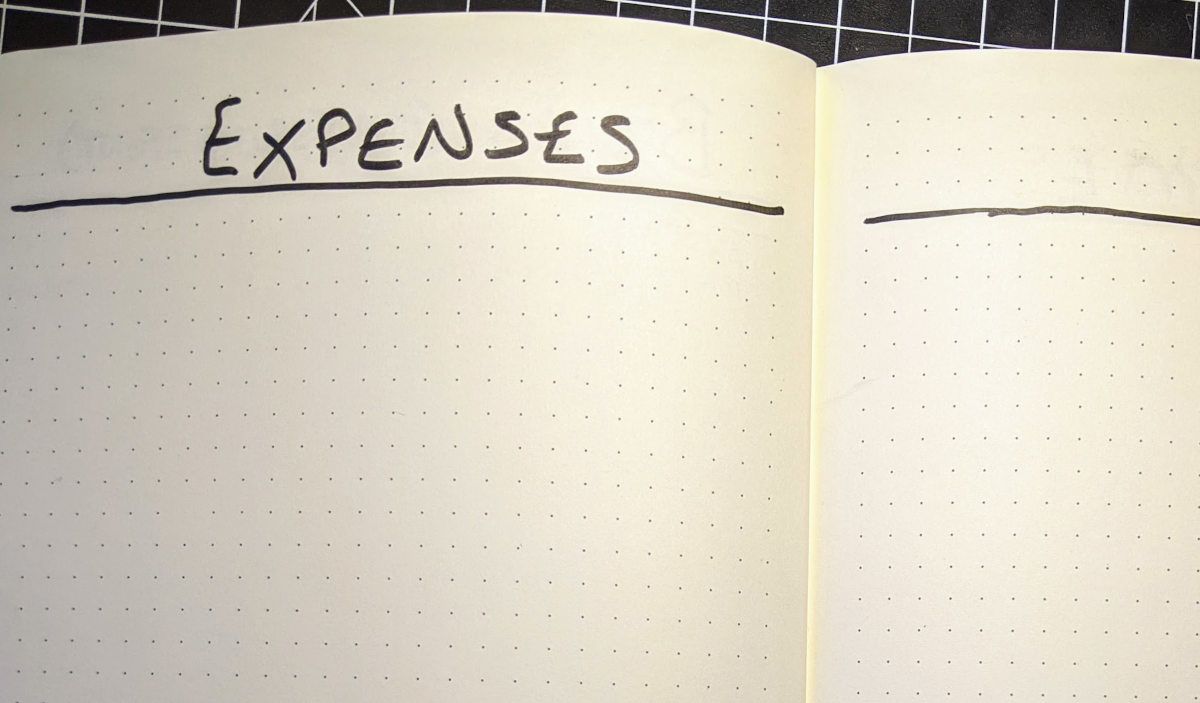
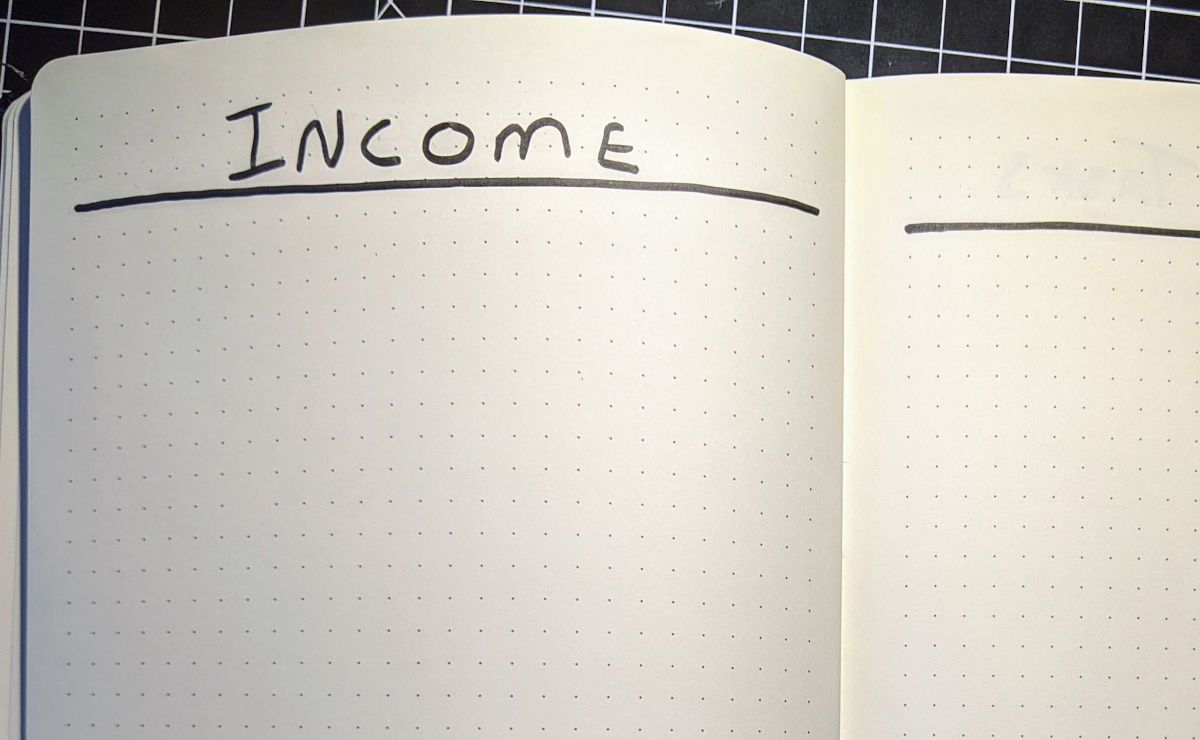
I will track a long LONG running list of tasks for my "Farm Tasks" collection (not shown) and a more free-form "Farm Thoughts & Ideas" collection. Like all ideas-oriented colletions, I will explore ideas in my daily log and then eventually distill it to the collection where I will also include the page number leading back to that day of exploration and brainstorming.
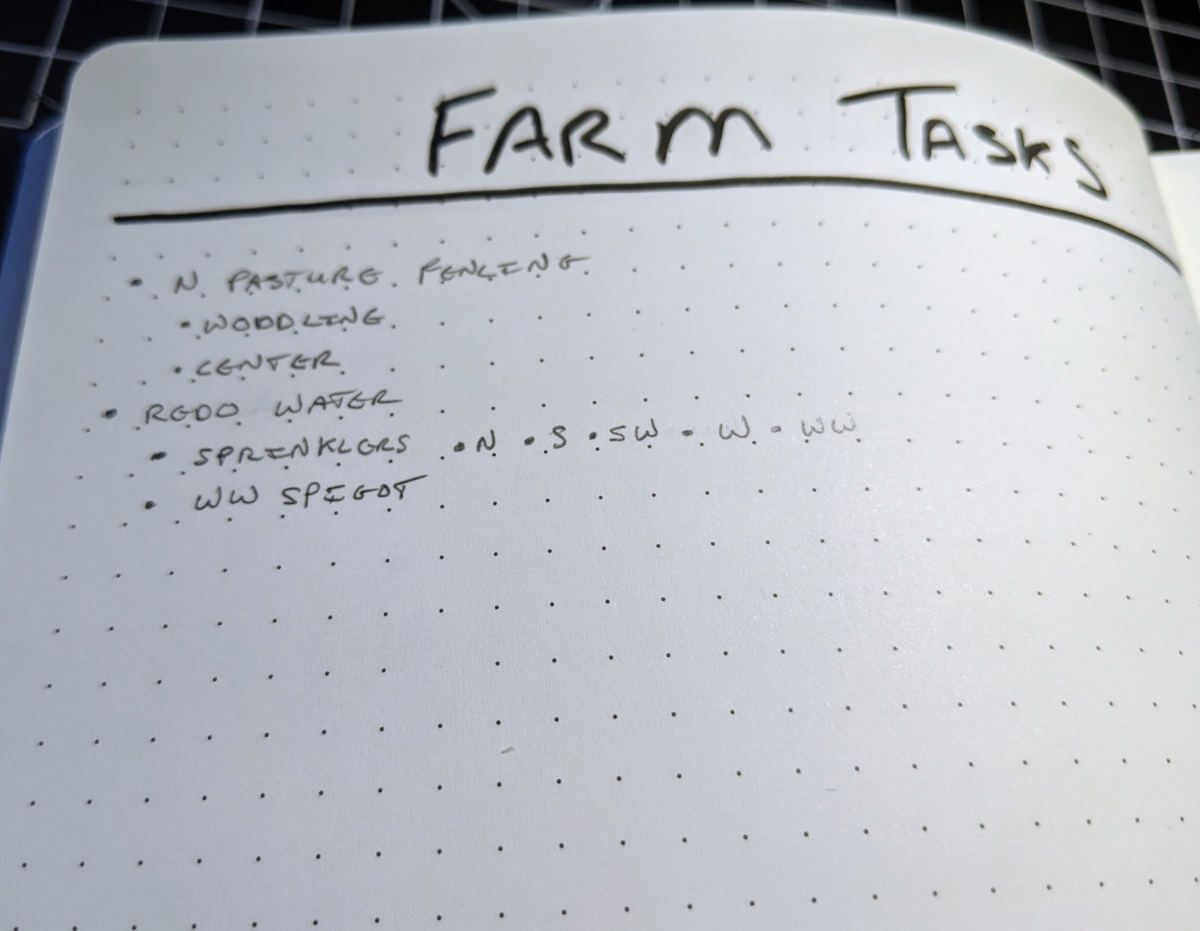
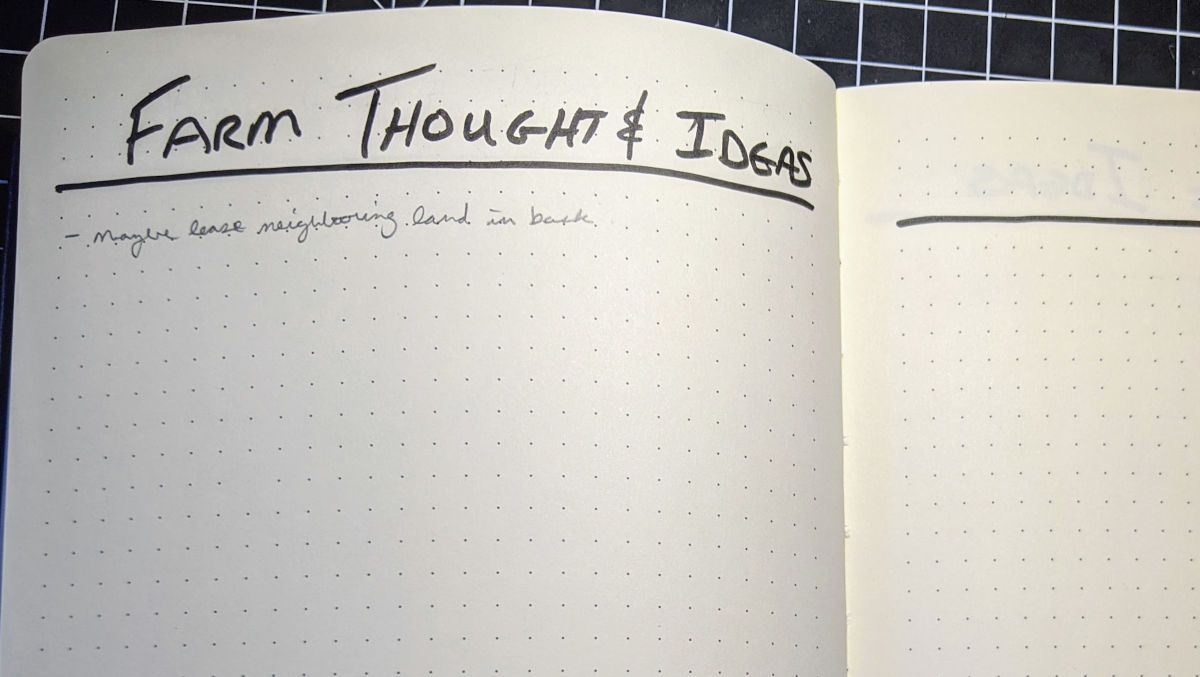
For my writing life, if I have an idea, I will usually explore it free-form in my current day's log (as before), but eventually I will try to distill it down and reenter it in the writing ideas collection. If I come across some awesome new word or phrase, I will stick it in my "Words, Phrases, Random Things" collection (not shown).
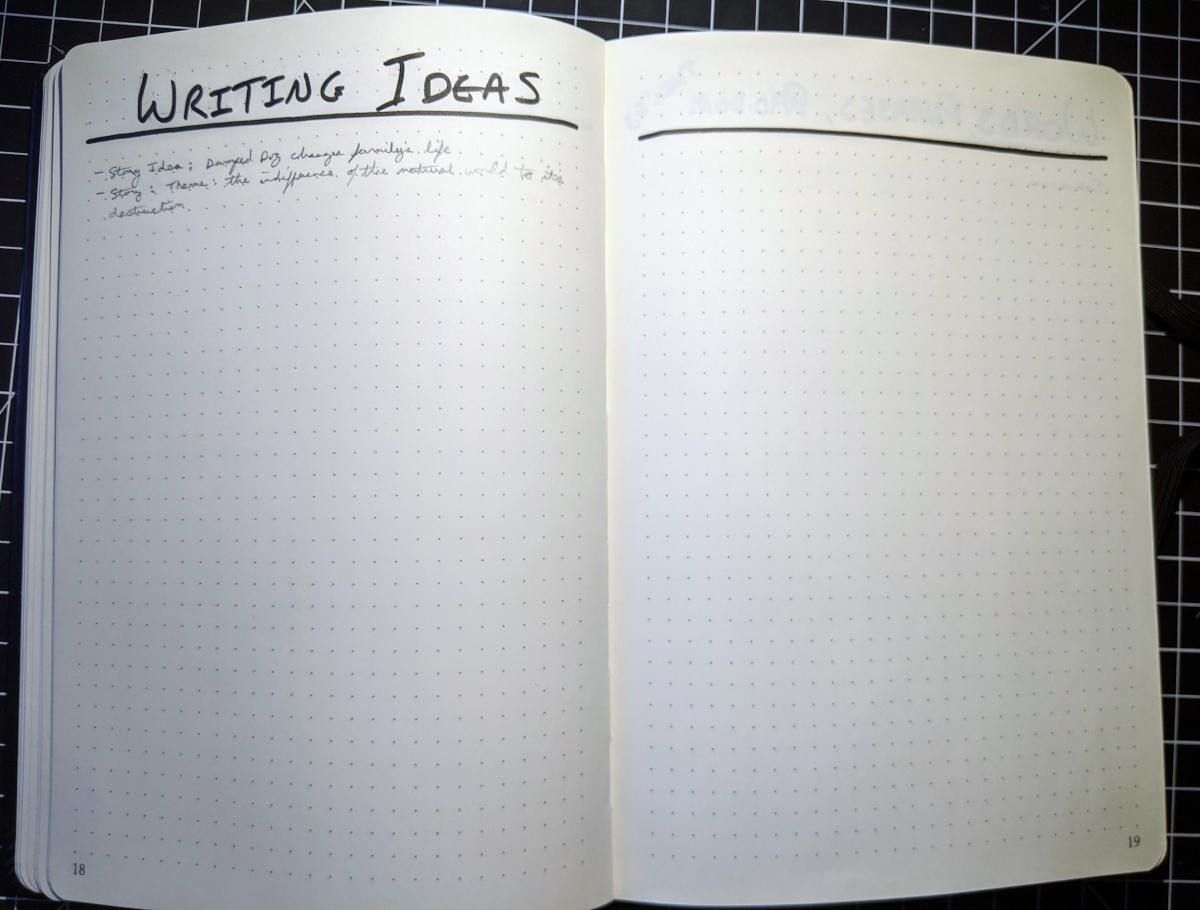
The "Good Things" collection will track events that I want to reflect upon. And the "Gloom, Despair, Agony" collection will track anything that causes me illness or pain (migraines, back pain, sad events, tick bites, etc.). You will notice this is a more chart-like tracker. My doctor found this thoroughly helpful in 2019.
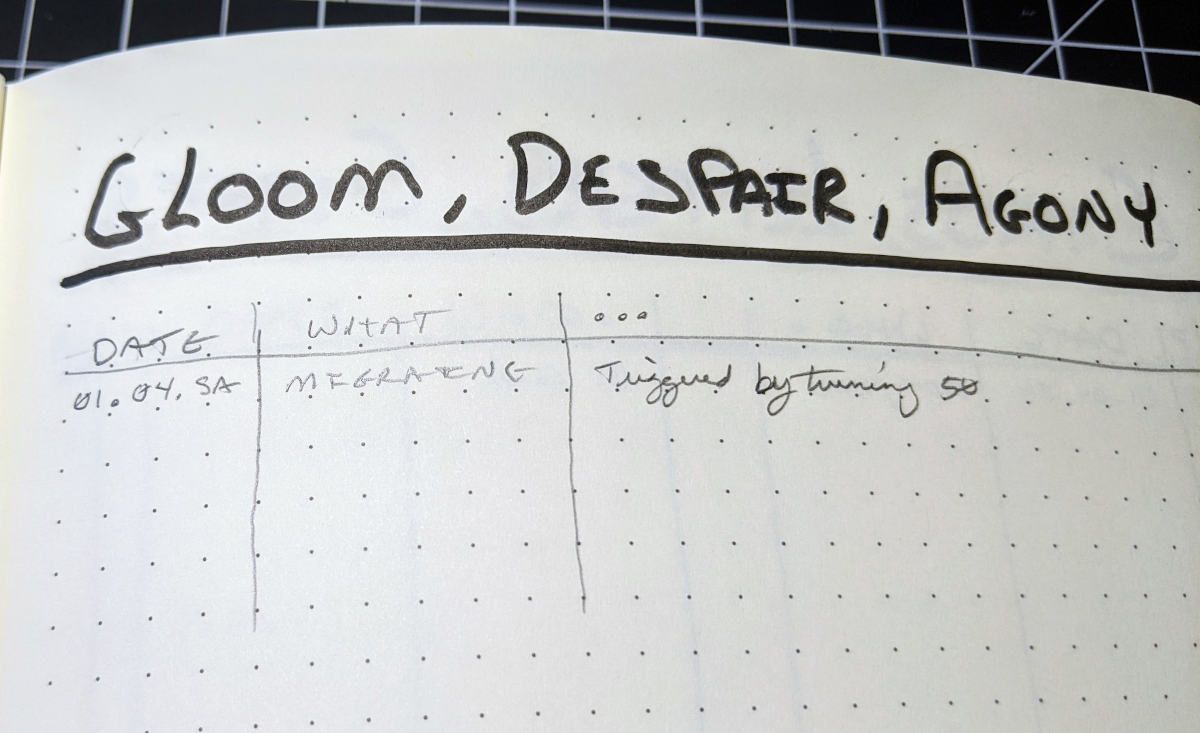
I made a vow in 2019 to be a more caring correspondent. I.e., I will write letters (actual letters) and send cards to people. You know, like a full-grown adult. I started keeping tabs on this last year and it was super helpful. I will do it again this coming year. It is very helpful to see that "Crap! Eve wrote me two months ago and I haven't responded!"
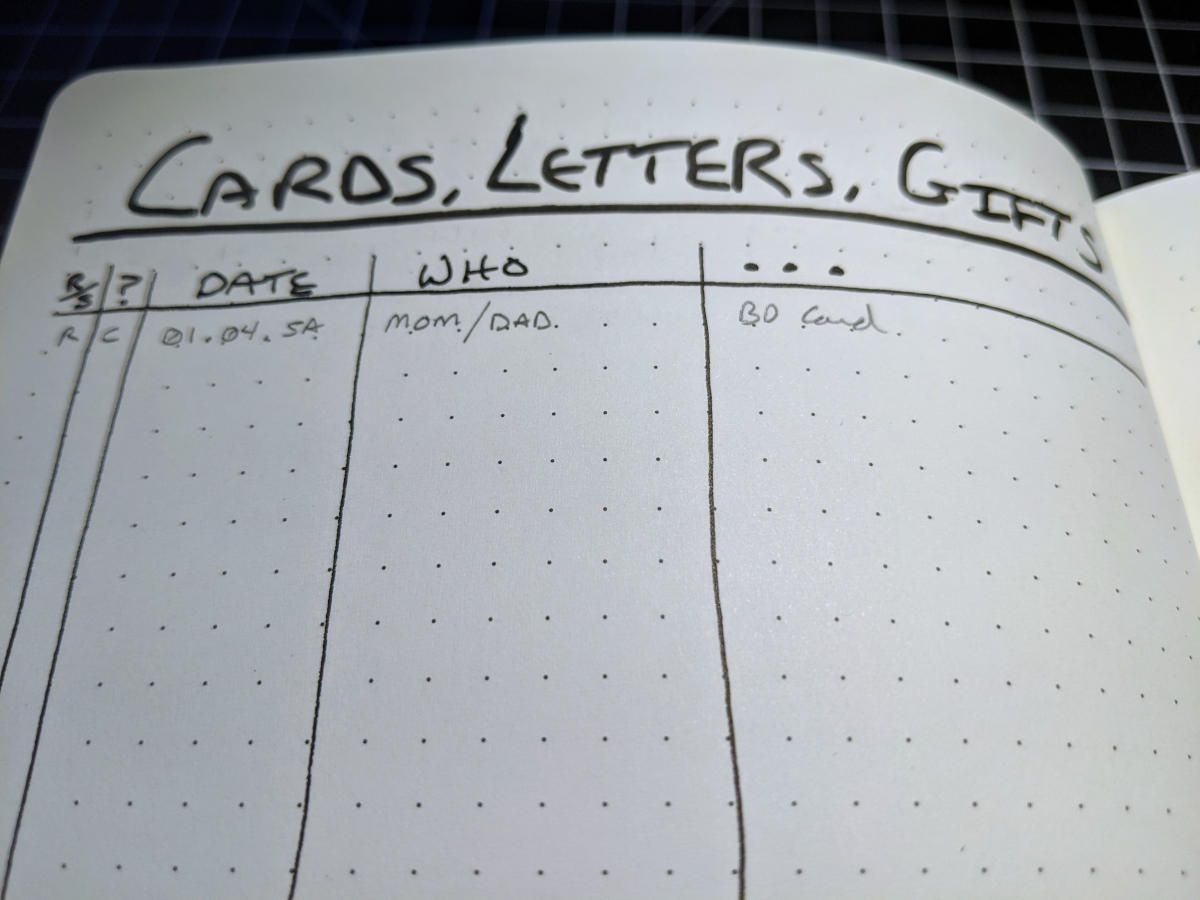
We own something like 30 domain names. And they are registered with a couple different services. This collection is an experiment. I want to track what we have and when they expire and where they are registered—all on one page—without having to look it all up on a computer.
Family medical history: I need (we all need) a detailed family medical history record. Every time I go to the doctor I remember one additional tidbit about my families past. Even then, I'm sure I don't really have the correct information. This is an important to-do for me this year.
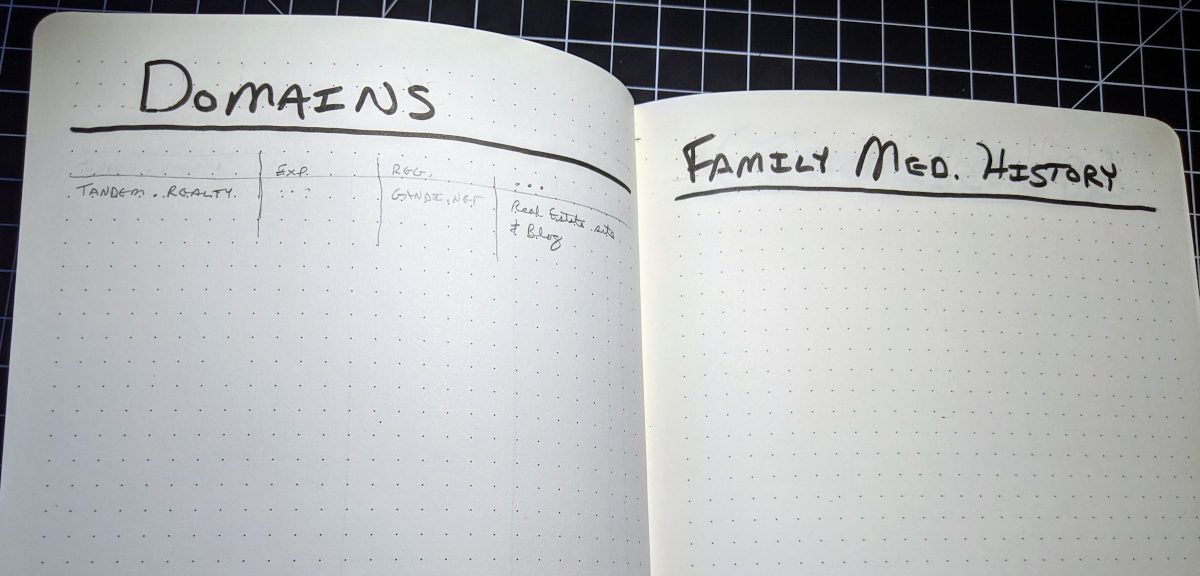
Monthly + Daily Logs
The "Month Log" for any given month is a two-page+ spread and the spread for that month is not created until you approach it at the end of the previous month. The first page assigns events (and major date-sensitive tasks) to a precise date listed to the left side. The second page will keep a running list of tasks for the month. Events to the left (1st page). Tasks to the right (2nd page).
I added a writer's word-count chart to that second page as well. If I run out of room in the process of adding all my tasks, I will probably change how I format the page spread for the next month and/or just add a third page.
The events on the first page are initially populated from events listed in the Future Log. I don't mark events as migrated. I just copy them over. Events happen (or are canceled). Tasks move around in time and are completed, or not.
The running tasks list on the second page is initially populated from migrated tasks from the Future Log and tasks that were not completed the prior month. Then as the month rolls along, more tasks and events may arrive as side-effects of meetings, collections that are fleshed out, and probably a ton of items generated on the fly. If you migrate a task from elsewhere, they should be marked as migrated at their original page and then copied to the destination (> if scheduled forward and < if scheduled backward). IMPORTANT: Distill, summarize, and trim the fat from these tasks and events before they land on that page two of the "Month Log".
If during the course of the month something gets punted to a different month, migrate it back to the Future Log making sure it lands in the appropriate spot. Or you leave it in place and migrated it when you are creating the running task list for the new month. I play it by ear whether it seems appropriate to send it back to the Future Log or just leave it to get curated during a new Monthly Log setup.
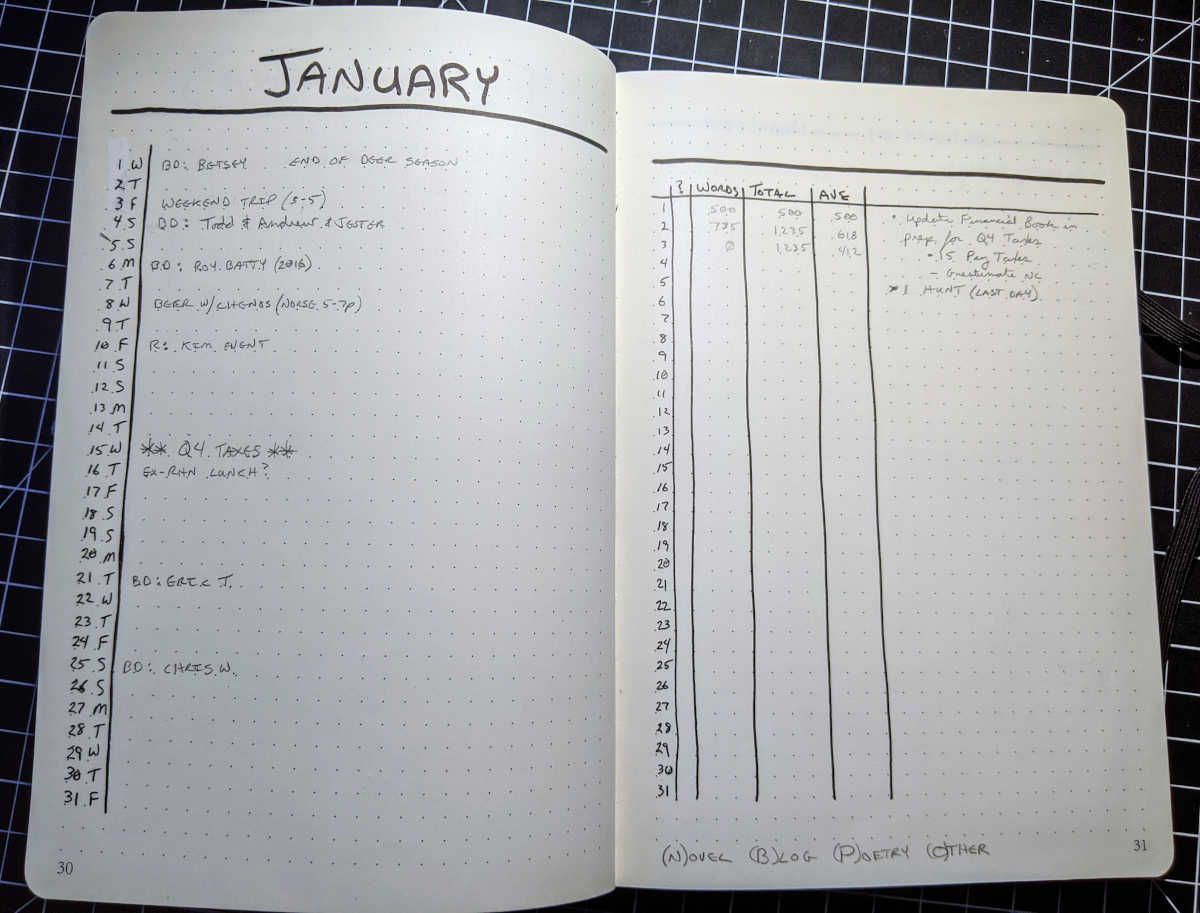
The Daily Log. A bullet journal is fleshed out on a daily basis. Generally, you don't plot out days in advance. That's what the current month's "Month Log" is for; and for other months, the Future Log. At the end of each day, I create the next day's entry and take some time (10 to 20 minutes) to map out what I intend to do that day. Then in the morning (and throughout the day) I revisit that entry.
Only one day is shown in this photo—and it is not detailed enough, admittedly—but think of it this way: a daily entry can be of any length and detail—it may be ten lines long; ten pages long; or even sometimes simply skipped. It's all up to you and how busy or detailed that day was. A day may include meeting notes, though depending on the meeting and your note-taking requirements, if meetings often generate copious notes, perhaps write those in another notebook and then, at the end of the day, distill them into that day's log or a collection and then funnel out the tasks to the "Future Log," your digital calendar, and the current month's task list. Whatever helps you maintain the organization.
Do you like to keep a diary? A bullet journal can serve that purpose too. Check out this video from Ryder Carroll: Journaling vs Bullet Journaling. He introduces a + symbol for directing attention to the narrative found on the page.
If the notebook fills up before the year is over, just start a new journal and continue where you left off. If your work is filling up the journal and your personal stuff is more manageable, maybe consider using one journal for work and one for personal use. I find it more helpful to keep everything in one place. It offers more continuity, and in the end, I am one person with 24 hours in a day, 365 days in a year.
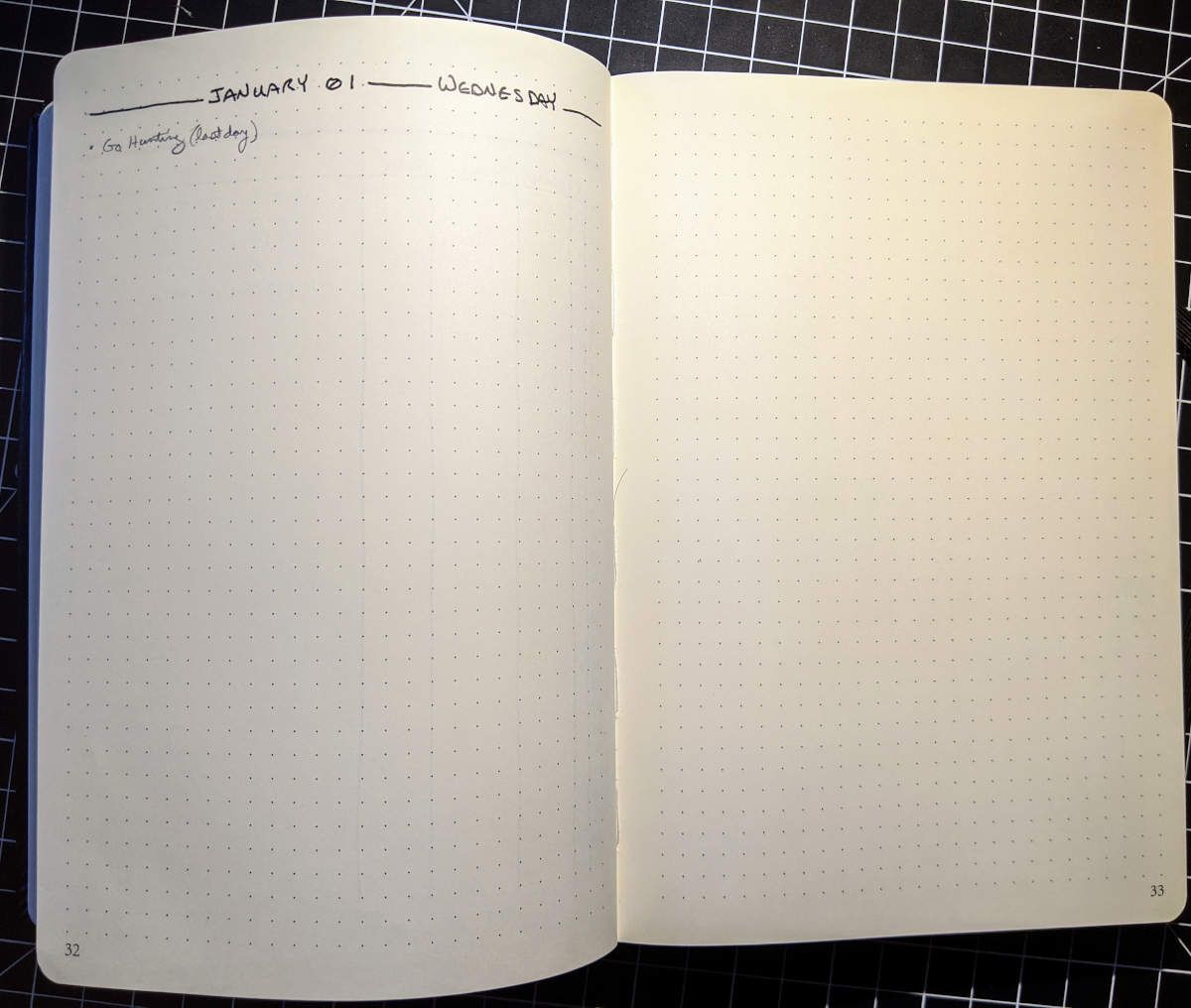
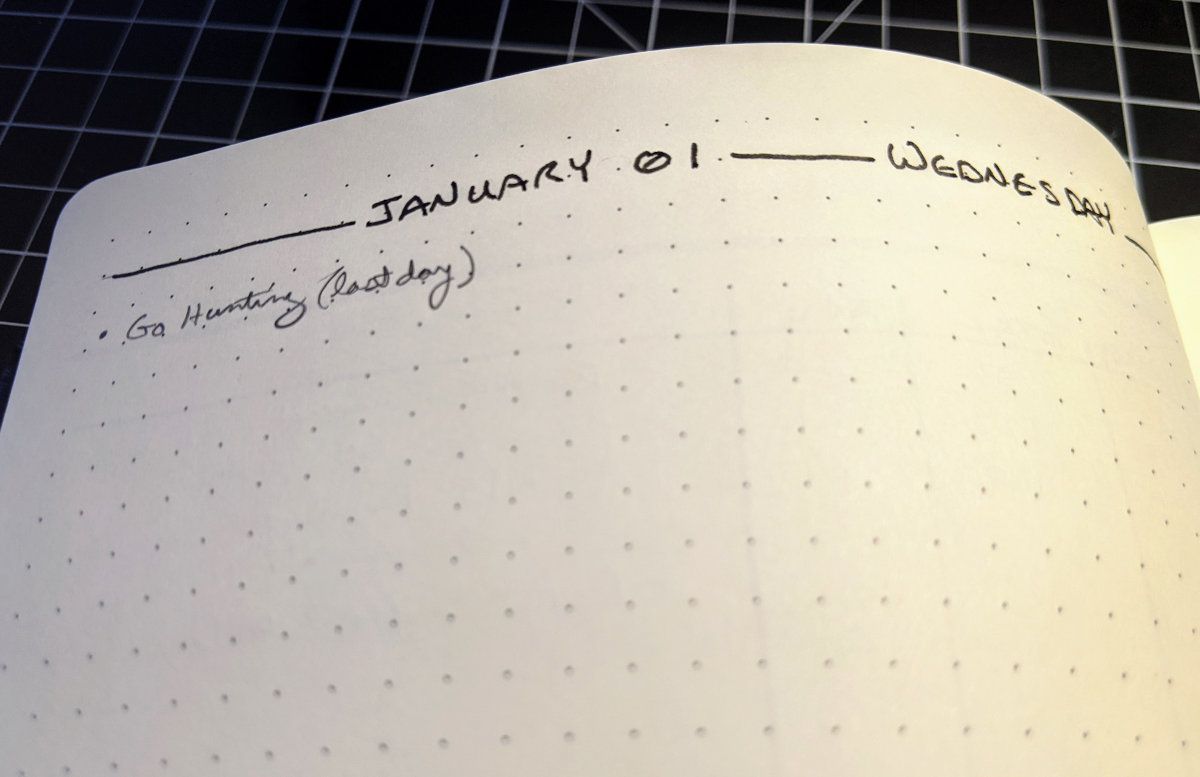
Organize Your Life
The Bullet Journal Method can help bring order to the chaos of your life. Heck, the mere act of attempting to write this stuff down will move the needle. Get in the habit and it can be life-changing. Bullet journaling does not require expensive tools, nor it does require rigidity of process; but it does ask you to be consistent and to think "year, month, day" zooming in and out within those temporal views.
Beyond initial setup and maybe each month's setup, note-taking and journaling in this way should feel rather effortless. You have to keep on top of things anyway, why not do it with a bit more intention and mindfulness. The Bullet Journal Method can help you do that.
I hope you found this article helpful, or at the very least maybe it gave you a few ideas. I encourage everyone to give the Bullet Journal Method a try. As I flesh out 2020's journal, I will likely write a follow up to this article, so . . . stay tuned.

